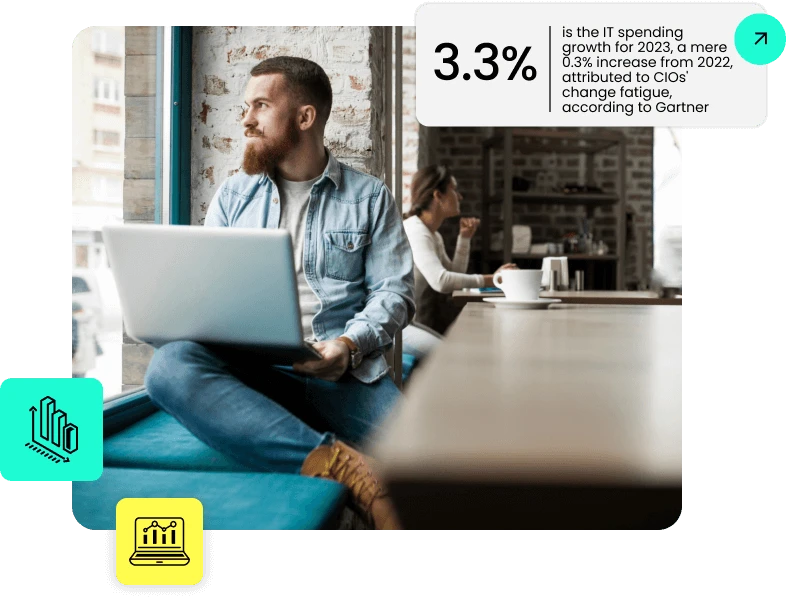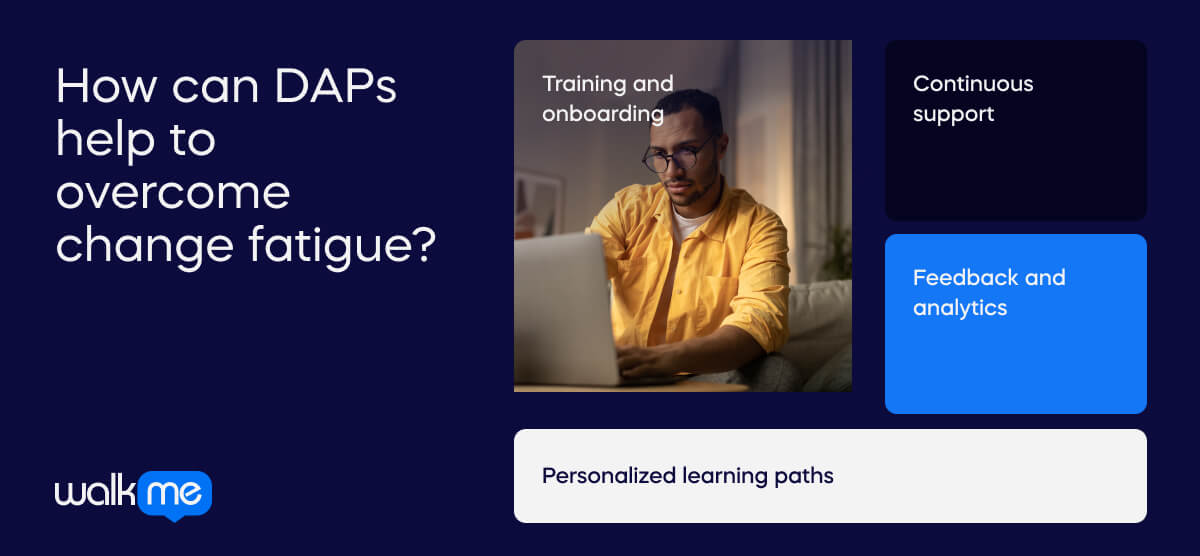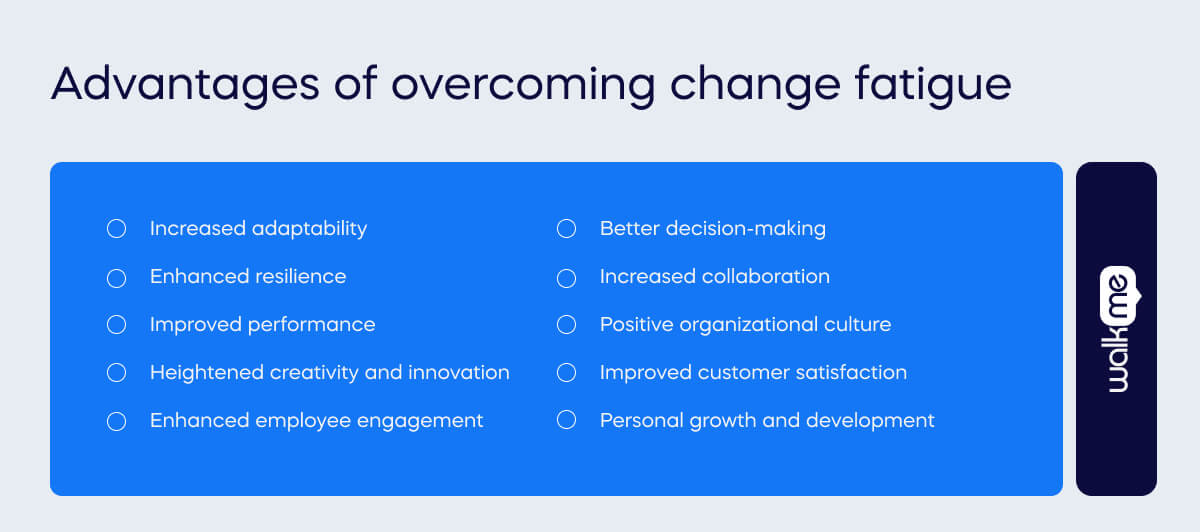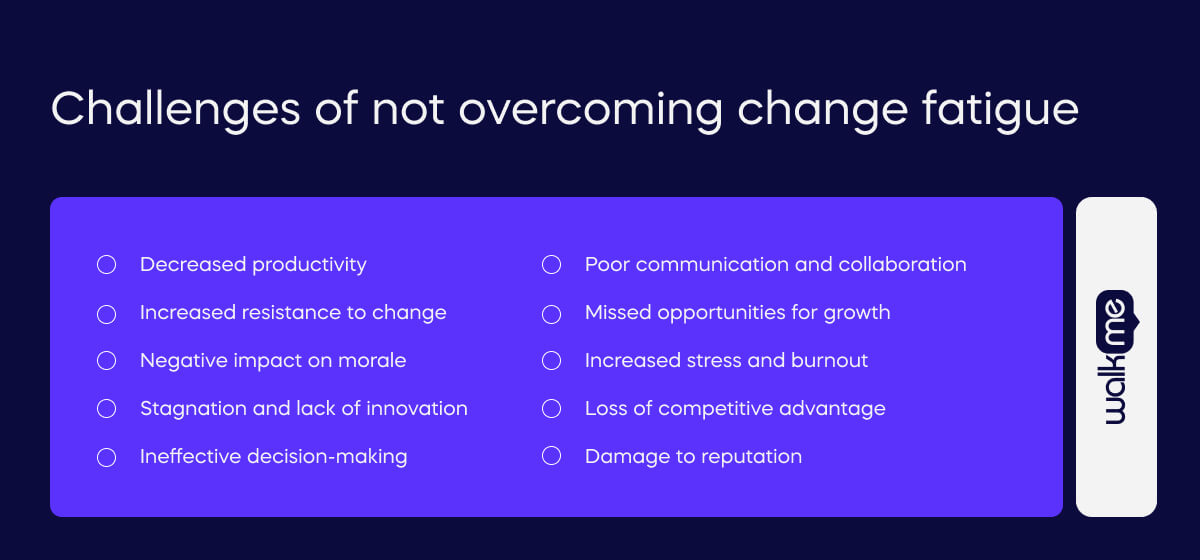What is Change Fatigue?
Change fatigue refers to the exhaustion, resistance, or decreased capacity to adapt that individuals or organizations may experience when subjected to a high frequency or magnitude of changes, whether in processes, structures, technologies, or strategies.

Table of contents
It typically arises when there’s a constant stream of changes without adequate time for people to adapt, recover, or internalize the previous changes. This phenomenon can lead to decreased morale, productivity, and engagement among employees or members of an organization. It can also manifest as skepticism or resistance towards new initiatives, as individuals may feel overwhelmed or disillusioned by the continuous state of flux. Organizations can mitigate change fatigue by implementing effective change management strategies, providing support and resources to help individuals navigate change, and ensuring clear communication and transparency throughout the change process.
How can DAPs help to overcome change fatigue?

Digital Adoption Platforms (DAPs) are designed to facilitate and streamline the adoption of new digital tools, systems, and processes within organizations. They are instrumental in helping organizations overcome change fatigue by providing comprehensive training, continuous support, and personalized learning experiences that empower users to adapt successfully to new digital tools and processes. The platforms can play a crucial role in mitigating change fatigue by providing the following:
Training and onboarding
Users find a wealth of training materials, tutorials, and onboarding resources within DAPs, facilitating their familiarity with new digital tools and technologies. Take, for instance, WalkMe’s Smart Walk-Thrus, which expertly guides users through tasks and processes across applications. Additionally, ShoutOuts delivers timely messages, notifying users about new features, updates, or tips. WalkMe further enhances learning with Launchers, granting users on-demand access to training resources like videos, documents, and webinars. Through this comprehensive approach, organizations diminish the learning curve associated with change, empowering users to feel more confident and competent.
Continuous support
Continuous support and assistance are facilitated for users navigating digital tools and workflows. Features like contextual help, chat support, and knowledge bases stand ready to aid users encountering challenges or questions. For example, WalkMe’s SmartTips offer contextual assistance based on user actions, while WalkMe Chat facilitates direct communication with experts or peers. Meanwhile, WalkMe Search enables users to swiftly find relevant information across all available training and support resources. Immediate support within the DAP platform allows organizations to address user concerns promptly, mitigating frustration and preventing change fatigue.
Feedback and analytics
Analytics dashboards and feedback mechanisms are often incorporated with DAPs, empowering organizations to track user engagement, pinpoint areas for improvement, and gauge the efficacy of their digital adoption endeavors. WalkMe’s Insights furnish a comprehensive dashboard displaying key metrics and trends on user behavior and satisfaction. Meanwhile, WalkMe Surveys gather feedback on user experiences. Additionally, WalkMe Goals enable organizations to define and monitor outcomes tied to their digital adoption initiatives. Organizations can preemptively tackle challenges by monitoring user interactions and gathering feedback before they exacerbate change fatigue.
Personalized learning paths
Tailored learning paths and recommendations to individual user needs and proficiency levels are easily created using DAPs, ensuring optimal support and training. For example, ActionBot utilizes AI to furnish personalized suggestions and automation. Furthermore, WalkMe Segmentation allows organizations to tailor training and support resources based on user attributes and behavior. With these personalized learning experiences, DAPs enable users to build skills gradually and navigate change without feeling overwhelmed.
Use cases for change fatigue
Change fatigue in business
Here are three examples of how change fatigue can manifest in various business scenarios:
Frequent organizational restructuring
A large corporation undergoes three major restructurings within a span of two years. Each restructuring involves changes in leadership, reporting structures, departmental alignments, and job roles. Employees must constantly adjust to new managers, teams, and responsibilities, leading to confusion, uncertainty, and a sense of instability. Despite initial optimism for positive outcomes, employees become fatigued by the persistent upheaval, resulting in decreased morale, productivity, and retention.
Rapid technology implementations
A mid-sized manufacturing company decides to implement a new Enterprise Resource Planning (ERP) system to streamline operations and improve efficiency. The rollout is rushed, with minimal training and support provided to employees. As a result, workers struggle to adapt to the complex interface and new processes, leading to errors, delays, and frustration. Despite efforts to troubleshoot issues and provide additional training, employees feel overwhelmed by the rapid pace of technological change and persistent workflow disruptions, contributing to change fatigue. This feeling can also impact CIOs. Gartner’s research reveals that their change fatigue resulted in the overall IT spending growth for 2023 being 3.3% – only a 0.3% increase from 2022. Unfortunately, CIOs don’t discuss their change fatigue in the context of business technology initiatives. Ultimately, 8 out of 10 who hold this position in organizations do not address work fatigue.
Merger and acquisition integration
Two companies in the healthcare sector merge to capitalize on synergies and expand their market share. However, the integration process is prolonged and chaotic, with conflicting cultures, systems, and processes creating significant employee challenges. Staff members must navigate new policies, procedures, and reporting structures while maintaining productivity amidst the uncertainty. Despite assurances from leadership about the long-term benefits of the merger, employees become increasingly fatigued by the constant changes and uncertainties, leading to decreased engagement and a loss of talent.
Success stories with overcoming change fatigue
DAPs like WalkMe are instrumental in helping organizations with overcoming change fatigue. Here are two examples of how WalkMe helped companies improve internal processes:
W. L. Gore
L. Gore enlisted WalkMe’s help to create a more effective system for communicating regular process changes, new feature rollouts, and enhancements within Salesforce.
They were also unsure how to best train end users to utilize the software for specific roles or divisions. To avoid training overheads, knowledge loss, updating support materials, and the resulting change fatigue, Gore implemented several WalkMe features:
- Personalized training and communication for specific users within Salesforce
- Insights into user adoption and usage metrics to identify bottlenecks
- In-application messaging strategy with ShoutOuts leading up to new feature releases or changes
- Walk-Thrus helps users understand new features
- SmartTips and Launchers help users get the answers they need both quickly and during their flow of work
Gore experienced a 50% increase in Salesforce user satisfaction thanks to their digital adoption strategy. Users no longer needed to ask colleagues for support or open tickets for how-to questions, streamlining their daily processes and improving workloads for the development teams.
Paychex
Paychex sought WalkMe’s help with transitioning users to Lightning without needing to spend time searching through training materials or watching webinars. To facilitate overcoming change fatigue with new processes to follow and updates to learn about, WalkMe implemented the following solutions:
- Smart Walk-Thrus to provide step-by-step guidance through complex processes
- Customizable help is provided at the point where assistance is needed to ensure accuracy and productivity
- ShoutOuts to draw attention to new features or processes being introduced
- Insights to track user engagement and adoption
Since the changes, over 3000 sales reps switched to Lightning within six months.
Change fatigue vs change saturation
Change fatigue and change saturation are related concepts but with some distinctions. While change fatigue and change saturation both involve challenges related to managing organizational change:
- Change fatigue specifically refers to the individual or collective exhaustion and resistance to change
- Change saturation pertains to the organization’s capacity to absorb and manage further changes effectively
Here’s an overview:
| Change fatigue | Change saturation | |
| Definition | Refers to the exhaustion, resistance, or decreased capacity to adapt that individuals or organizations may experience when subjected to a high frequency or magnitude of changes. | Occurs when an organization reaches a point where it cannot effectively absorb or manage any further changes. |
| Characteristics | Typically arises when there is a continuous stream of changes without adequate time for people to adapt, recover, or internalize the previous changes. | Occurs after a prolonged period of intensive change initiatives or when multiple changes are implemented simultaneously, overwhelming the organization’s capacity to adapt. |
| Effects | Can lead to decreased morale, productivity, and engagement among employees or members of an organization. It can manifest as skepticism or resistance towards new initiatives due to feeling overwhelmed or disillusioned by the constant state of flux. | Can result in diminishing returns on change efforts, as employees or systems become overstretched and unable to effectively implement or sustain additional changes. It can lead to increased resistance, decreased morale, and a sense of burnout among employees. |
Both concepts highlight the importance of carefully managing the pace, frequency, and magnitude of changes to ensure successful outcomes and minimize negative impacts on employees and organizational performance.
Advantages of overcoming change fatigue

Overcoming change fatigue can offer several advantages:
Increased adaptability
Individuals and organizations become more adept at navigating change, making them better equipped to handle future challenges and uncertainties.
Enhanced resilience
Overcoming change fatigue builds resilience, enabling individuals and teams to bounce back more quickly from setbacks or adverse circumstances.
Improved performance
With reduced resistance to change, productivity and performance levels often rise as people focus more on adapting to new situations rather than dwelling on what has changed.
Heightened creativity and innovation
Embracing change fosters a culture of innovation as individuals feel more comfortable exploring new ideas and experimenting with different approaches.
Enhanced employee engagement
Employees are more likely to feel valued and engaged when they perceive that their concerns about change are being addressed and their input is considered, leading to higher morale and retention rates. Indeed, Gartner reports that change fatigue rates can drop by up to 46% when employees feel their managers have created a psychologically safe environment.
Better decision-making
Overcoming change fatigue encourages open-mindedness and critical thinking, which can lead to more informed and effective decision-making processes.
Increased collaboration
When people are less resistant to change, they are more willing to collaborate and share knowledge, leading to stronger teamwork and collective problem-solving.
Positive organizational culture
Successfully managing change fosters a culture of trust, transparency, and continuous learning, which can have long-term benefits for organizational growth and sustainability.
Improved customer satisfaction
Organizations that adapt quickly to changing market conditions are better positioned to meet customer needs and expectations, leading to higher satisfaction and loyalty.
Personal growth and development
Overcoming change fatigue often involves personal growth and development as individuals learn new skills, gain confidence in their abilities, and become more adaptable and resilient in the face of change.
Challenges of not overcoming change fatigue

Not overcoming change fatigue can pose several challenges:
Decreased productivity
When individuals and teams are fatigued by change, they may become less motivated and productive, leading to missed deadlines, decreased output, and lower-quality work.
Increased resistance to change
Persistent change fatigue can result in heightened resistance to future changes, making it difficult for organizations to adapt to evolving market conditions or implement necessary improvements.
Negative impact on morale
Employees experiencing change fatigue may feel overwhelmed, stressed, or disengaged, which can harm morale and team dynamics. This can lead to higher turnover rates and lower levels of employee satisfaction.
Stagnation and lack of innovation
A culture of change fatigue can stifle innovation and creativity as individuals focus more on maintaining the status quo rather than exploring new ideas or approaches.
Ineffective decision-making
Change fatigue can impair decision-making processes as individuals may be less receptive to new information or alternative perspectives, leading to suboptimal choices or missed opportunities.
Poor communication and collaboration
Communication breakdowns and a lack of collaboration are common when change fatigue is prevalent, hindering teamwork and coordination across departments or teams.
Missed opportunities for growth
Organizations that struggle to overcome change fatigue may miss out on opportunities for growth and development, as they cannot adapt to emerging trends or capitalize on new market opportunities.
Increased stress and burnout
Persistent change fatigue can contribute to higher levels of stress and burnout among employees, leading to absenteeism, decreased job satisfaction, and potential health issues.
Loss of competitive advantage
In rapidly changing industries, failing to overcome change fatigue can result in a loss of competitive advantage as more agile and adaptable competitors gain market share and innovate more effectively.
Damage to reputation
Continuously struggling to manage change can damage an organization’s internal and external reputation, as stakeholders may perceive it as being resistant to progress or unable to navigate challenges effectively.
Future of overcoming change fatigue with DAPs
Digital Adoption Platforms (DAPs) represent a transformative solution in the realm of change management, particularly in combating the pervasive issue of change fatigue within organizations. These platforms offer a multifaceted approach to tackling resistance to change by providing targeted support and guidance while adopting new technologies and processes. Through personalized learning experiences, DAPs empower individuals to confidently navigate transitions, offering tailored training and support resources that align with their unique needs and skill levels.
One key advantage of DAPs is their ability to deliver interactive guidance and support directly within the software interface. By incorporating features such as walkthroughs, tooltips, and interactive tutorials, these platforms enable users to overcome obstacles and navigate complex workflows seamlessly. Furthermore, DAPs leverage data-driven insights to inform decision-making, offering organizations valuable feedback on user behavior, adoption rates, and areas of resistance. This data-driven approach allows continuous refinement of training and support strategies, ensuring they remain relevant and effective. Moreover, DAPs integrate seamlessly with existing change management processes and tools, providing organizations with a cohesive approach to managing change initiatives. By aligning DAPs with organizational goals and strategies, businesses can maximize their effectiveness in addressing change fatigue and driving successful outcomes. Additionally, the incorporation of gamification elements and incentives within DAPs motivates users and fosters a culture of engagement, making adopting new technologies and processes a more enjoyable and rewarding experience.
Accessibility is another hallmark feature of DAPs, with many platforms offering mobile accessibility to accommodate diverse learning styles and preferences. This flexibility empowers users to access training and support materials anytime, anywhere, facilitating continuous learning and development. Finally, the scalability and flexibility of DAPs make them suitable for organizations of all sizes and industries, whether onboarding new employees or rolling out updates to existing systems. The future of overcoming change fatigue with Digital Adoption Platforms is promising. By leveraging the capabilities of DAPs, organizations can minimize resistance to change, accelerate adoption rates, and drive success in an increasingly dynamic and competitive business environment. These platforms represent a strategic investment in organizations’ long-term growth and resilience, offering a comprehensive solution to the challenges of change management and fatigue.